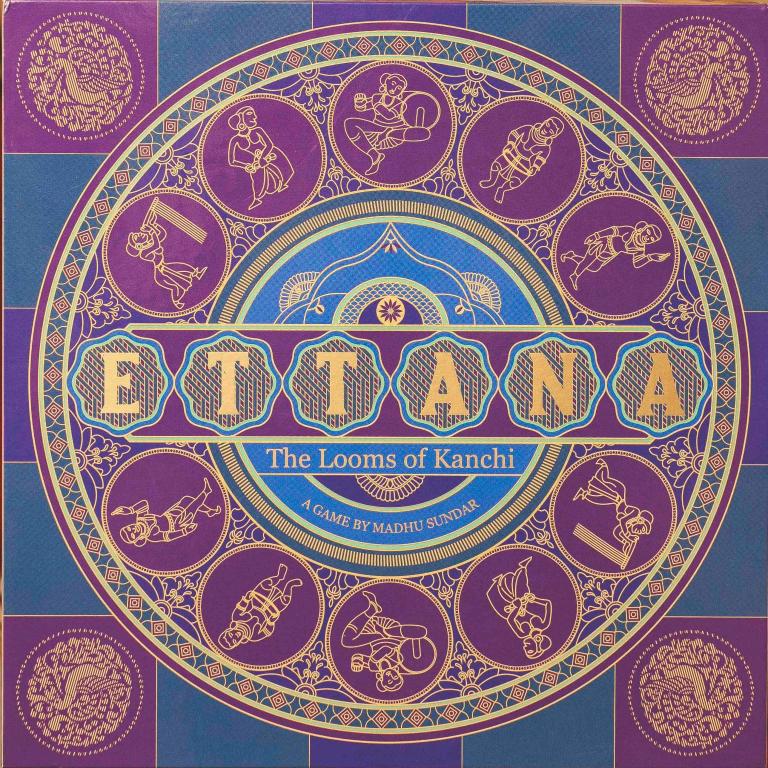Ettana: The Looms of Kanchi

Ettana: The Looms of Kanchi
Indian handlooms date back several centuries. The tradition of weaving by hand formed a part of the country's cultural ethos. A piece of fabric with a design could indicate the meaning, its purpose, the culture of the era, and even the way the people lived. Handlooms thus became a precious part of the generational legacy and exemplify the richness and diversity of a country and the artistry of the weavers.
Innovative weavers with their skillful blending of myths, faiths, symbols, and imagery provide the fabric an appealing dynamism. The appeal of the handloom lies in introducing innovative designs that cannot be easily replicated. This rich tradition of hand weaving still thrives at Kanchi, a prominent temple town in South India. Fabrics were part and parcel of trade done by the Indian weavers for which they got back "Annas" or goods in return.
In Ettana: The Looms of Kanchi, players take the role of weavers to complete designs and be the first to make eight "Annas" (victory points). In detail, set up the 5x5 game board by placing one of 25 yarn discs (five of each in five colors) on each space, then place 16 of the 18 number tiles (three each of the numbers 1-6) at the intersections of the spaces on the game board; place the remaining two number tiles on the side in the reserve, along with one yarn disc of each color. Each player receives a random action card, a random design card, and two tokens with a value of 1. Each player places their pawn on one number tile.
On a turn, you roll the two dice: a color die and a number die. If a player's pawn is touching a space that shows the color rolled, they receive a 1 token; if the die shows black, which is not a yarn color, you take an action card and no one else gets anything. You can then move your pawn as many spaces as the number rolled, after which you can swap two yarn adjacent to your location. Additionally, you can play as many action cards as you wish, and you can pay tokens to take design cards, take action cards, and swap any two yarns. Action cards allow you to move, swap, gain tokens, replace a yarn or number with one from the reserve, etc.
If the pattern of yarn on the board matches a design card in hand, you can reveal that card to score its points.
Innovative weavers with their skillful blending of myths, faiths, symbols, and imagery provide the fabric an appealing dynamism. The appeal of the handloom lies in introducing innovative designs that cannot be easily replicated. This rich tradition of hand weaving still thrives at Kanchi, a prominent temple town in South India. Fabrics were part and parcel of trade done by the Indian weavers for which they got back "Annas" or goods in return.
In Ettana: The Looms of Kanchi, players take the role of weavers to complete designs and be the first to make eight "Annas" (victory points). In detail, set up the 5x5 game board by placing one of 25 yarn discs (five of each in five colors) on each space, then place 16 of the 18 number tiles (three each of the numbers 1-6) at the intersections of the spaces on the game board; place the remaining two number tiles on the side in the reserve, along with one yarn disc of each color. Each player receives a random action card, a random design card, and two tokens with a value of 1. Each player places their pawn on one number tile.
On a turn, you roll the two dice: a color die and a number die. If a player's pawn is touching a space that shows the color rolled, they receive a 1 token; if the die shows black, which is not a yarn color, you take an action card and no one else gets anything. You can then move your pawn as many spaces as the number rolled, after which you can swap two yarn adjacent to your location. Additionally, you can play as many action cards as you wish, and you can pay tokens to take design cards, take action cards, and swap any two yarns. Action cards allow you to move, swap, gain tokens, replace a yarn or number with one from the reserve, etc.
If the pattern of yarn on the board matches a design card in hand, you can reveal that card to score its points.
Player Count
2
-
4
Playing Time
25
-
60
Age
8
Year Released
2021
Newest Review
Remote video URL